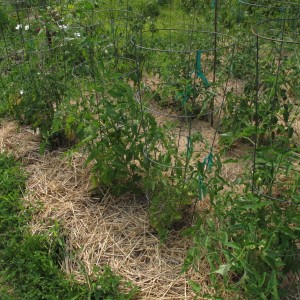Mulching
I love the musical Porgy and Bess, especially the song, “Summertime,” with its catchy refrain, “Summertime and the livin’ is easy”. Clearly Gershwin was a) not a gardener, or b) he mastered the art of mulching. Mulching makes the summer easy, if done right. No mulch? The summer is spent weeding and watering. If you’re still weeding, it’s time to mulch.
My vegetable garden gets mulched in June as soon as the soil has warmed up. I take a sharp hoe and slice off any weeds in the walkways, and lay down 6 pages of newspapers. Then I cover the papers with mulch hay or straw. Straw is supposed to be free of seeds as it is the stems of oats or other grains that have been threshed. But I often find the straw germinates and sends up green shoots.
Hay, on the other hand, is grass that is grown for animal food and harvested with stems and seeds intact. But mulch hay is much cheaper than straw – a quarter the cost – and I find it doesn’t generate any more undesirable growth than straw. The fact that I lay down newspapers helps – it keeps the seeds out of the soil until the end of the season.
Big plants like tomatoes and broccoli get the same treatment as the walkways. I do leave some space right next to the stalk of each plant that gets no newspaper – so a light rain shower can get moisture to the roots. Little plants like onions or carrots get hay alongside their rows, but no newspaper. You could tear the papers and lay them down, and I have done it, but it isn’t worth the bother.
Leaves collected in the fall are excellent mulch. I run them over with the lawnmower, which makes them more compact and less likely to blow around. An inch of chopped leaves is an adequate layer of mulch. Pine needles are also good mulch, despite the fact that they have the reputation of being too acidic. In my experience they are fine – any biologically active soil with earthworms, fungi and bacteria will breakdown the needles over time without making your soil too acidic.
I don’t generally recommend using wood chips or shredded bark in the vegetable garden, but do use it in flower gardens. Vegetable gardens tend to have rows that move from year to year, and I don’t really want wood chips mixed into the soil. Flower gardens have more or less permanent plantings, and the wood chips stay put.
Some gardeners worry that the microorganisms breaking down wood chips will use up nitrogen from the soil, causing a nitrogen deficiency. If that were true, a lot of flower gardens would have flowers with yellowed, anemic-looking leaves. If you want, you can sprinkle a layer of organic fertilizer on the soil before you mulch. Organic fertilizers are made from natural ingredients such as seaweed, chicken litter, oyster shells, peanut hulls or other natural ingredients, and all break down slowly, which is an advantage in most applications – including under mulch.
Be advised that many of the wood or bark mulches sold in bags are “color enhanced”. That means they have used dyes of some sort to make the mulch dark – or even bright orange. I am an organic gardener, so I won’t use dyed mulch. I don’t know what is used to make the colors, so I avoid it. Many garden centers sell all natural mulch in bulk, which is much less expensive than buying it by the bag. All you need is a pickup truck – or a friend that has one. Cedar mulch is the most expensive, but I believe it lasts the longest before it breaks down.
Cocoa hulls are sold as mulch with very fine particles of organic matter. This mulch looks very tidy. Mostly. Usually some mold will appear on it after a couple of weeks, but then that goes away. And a nice layer of it will make your yard smell like you’re cooking brownies. That’s fine, but some dogs have been known to eat the cocoa mulch and get sick or even die. It’s probably not for homes with Labrador retrievers. And the mulch can be slippery when wet. Buckwheat hulls are another fine, fancy mulch. It is only sold in bags, and costs a fortune. I love the look, but can’t afford to use it.
Landscape fabric comes in a variety of types, all of which purport to keep down weeds and allow air and moisture to pass through. Fabric needs to be covered with mulch – generally wood chips – and I find that eventually some weeds grow in the mulch and get tangled in the fabric.
One final word of caution: don’t apply too much mulch. More is not better. Two inches of bark mulch is fine, but a five -inch layer will prevent moisture from getting to your soil in a light rain shower. And plants get their oxygen from the soil, so you don’t want to create a barrier that will keep gases from being exchanged. Mulch won’t control everything. Annual weeds? Yes. But established perennial weeds like goutweed or witch grass cannot be controlled with mulch. Still, mulch can save you lots of work and make the livin’ easy. Or easier, anyway.
Henry Homeyer is the author of 4 gardening books. His web Site is www.Gardening-Guy.com.



